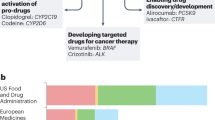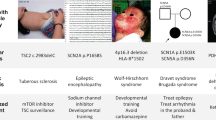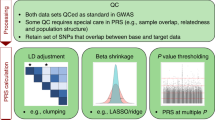Abstract
Pharmacogenetics arose with studies of single genes, which had major effects on the action of particular drugs. It turned into pharmacogenomics through realization that the controls of most drug responses are multifactorial. Then, variable gene expression posed new problems, for example what do drugs do to genes, or how useful is any genetic pretesting of a person? A common disease may be caused by different groups of genes in different people, who therefore require different drugs for treatment. Personlized medicine is currently represented by a physician's attention to a patients age, sex, or ethnic backround, that is groups showing smaller genetic variation than is typical for general humanity. Occasionally, there is also the use of single-gene pretesting of a patient before drug administration. Over time, improvements in multigenic testing promise to increase the role of personalized medicine. However, the many pharmacogenomic complexities, and particularly time-dependent changes of gene expression, will never allow personalized medicine to become an error-free entity.
This is a preview of subscription content, access via your institution
Access options
Subscribe to this journal
Receive 6 print issues and online access
$259.00 per year
only $43.17 per issue
Buy this article
- Purchase on Springer Link
- Instant access to full article PDF
Prices may be subject to local taxes which are calculated during checkout
Similar content being viewed by others
References
Garrod AE . Inborn Factors in Disease: An Essay, Oxford University Press: New York, NY.
Haldane JBS . Disease and evolution. Ric Sci 1949; 19: 68–75.
Snyder LH . Studies in human inheritance. IX. The inheritance of taste sensitivity in man. Ohio J Sci 1932; 32: 436–440.
Waldenstrom J . Studien uber Porphyrie. Acta Med Scand 1937; 82 (Suppl): 254–258.
Sawin PB, Glick D . Hydrolysis of atropine by esterase present in rabbit serum. Proc Natl Acad Sci USA 1943; 29: 55–59.
Beutler E . Study of glucose-6-phosphate dehydrogenase: history and molecular biology. Am J Hematol 1993; 44: 215–216.
Luzzatto L, Mehta A, Vulliamy T . Glucose-6-phosphate dehydrogenase deficiency. In: Scriver CR, Beaudet AL, Sly WS, Valle D (eds). The Metabolic and MolecularBases of Inherited Disease. McGraw-Hill: New York, NY, 2001 pp 4517–4553.
Kalow W . Familial incidence of low pseudocholinesterase level. Lancet 1956: 576.
Bonicke R, Lisboa BP . Uber die Erbbedingtheit der intraindividuellen Konstanz der Isoniazidausscheidung beim Menschen. Naturwissenschaften 1957; 44: 314–320.
Motulsky AG . Drug reactions, enzymes, and biochemical genetics. J Am Med Assoc 1957; 165: 835–837.
Vogel F . Moderne Probleme der Humangenetic. Ergeb Inn Med Kinderheilkd 1959; 12: 52–125.
Kalow W . Pharmacogenetics: Heredity and the Response to Drugs. W.B. Saunders, Philadelphia, PA: London, 1962.
Mahgoup A, Dring L, Idle JR, Lancaster R, Smith RL . Polymorphic hydroxylation of debrisoquine in man. Lancet 1977; 2: 584–586.
Smith R . The discovery of the debrisoquine hydroxylation polymorphism: scientific and clinical impact and consequences. Toxicology 2001; 168: 11–19.
Eichelbaum M, Spanbrucker N, Steinke BDengler HJ . Defective N-oxydation of sparteine in man: a new pharmacogenetic defect. Eur J Clin Pharmacol 1997; 16: 183–187.
Maraz D, Legrand M, Sabbagh N et al. Polymorphism of the cytochrome P450 CYP2D6 in a European population: characterization of 48 mutations and 53 alleles, their frequencies and evolution. Pharmacogenetics 1997; 7: 197–202.
Ingelman-Sundberg M . Genetic polymorphisms of cytochrome P450 2D6 (CYP2D6): clinical consequences, evolutionary aspects and functional diversity. Pharmacogenomics J 2005; 5: 6–13.
Kalow W . Interethnic differences in drug response. In: Kalow W, Meyer UA, Tyndale RF (eds). Pharmacogenomics. Marcel Dekker Inc., New York, 2001 pp 109–134.
Weber WW . Pharmacogenetics-receptors. In: Kalow W, Meyer UA, Tyndale RF (eds). Pharmacogenomics. Marcel Dekker Inc.: New York, 2001 pp 51–80.
Ho RH, Kim RB . Transporters and drug therapy: implications for drug disposition and disease. Clin Pharmacol Ther 2005; 78: 260–277.
Bondy B . Pharmacogenetics in depression and antidepressants. Dialogues Clin Neurosci 2005; 7: 223–230.
Kalow W . Ethnic differences in drug metabolism. Clin Pharmacokinetic 1982; 7: 373–400.
Kalow W, Tang BK, Kadar D et al. A method to study drug metabolism in populations: racial differences in amobarbital metabolism. Clin Pharmacol Ther 1979; 6: 766–776.
Oroszi G, Goldman D . Alcoholism: genes mechanisms. Pharmacogenomics 2004; 5: 1037–1048.
Bai X, Edwards J, Ju J . Molecular engineering approaches for DNA sequencing and analysis. Expert Rev Mol Diagn 2005; 5: 797–808.
Reyzer ML, Caprioli RM . MALDI mass spectometry for direct tissue analysis: a new tool for biomarker discovery. J Proteome Res 2005; 4: 1138–1142.
Romkes M, Buch SC . Strategies for measurement of biotransformation enzyme gene expression. Methods Mol Biol 2005; 291: 387–398.
Kersten B, Wanker EE, Hoheisel JD, Angenendt P . Multiplex approaches in protein microarray technology. Expert Rev Proteomics 2005; 2: 499–510.
Cordell HJ, Clayton DG . Genetic association studies. Lancet 2005; 366: 1121–1131.
Innocenti F (ed). Pharmacogenomics: Methods and Protocols. Humana Press: Totowa, New Jersey, 2005.
Couzin J . Small RNAs make big splash. Science 2005; 298: 2296–2297.
Madden SL, Wang C, Landes G . Serial analysis of gene expression; transcriptional insights into functional biology. In: Kalow W, Meyer UA, Tyndale RF (eds). Pharmacogenomics. Marcel Dekker Inc.: New York, 2002 pp 223–251.
Burgess JK . Gene expression studies using microarrays. Clin Exp Pharmacol Physiol 2001; 28: 321–328.
Wolffe AP, Matzke MA . Epigenetics: regulation through repression. Science 1999; 15: 481–486.
Cirelli C . A molecular window on sleep: changes in gene expression between sleep and wakefulness. Neuroscientist 2005; 11: 63–74.
Rossi EL . Psychosocial genomics: gene expression, neurogenesis, and human experience in mind-body medicine. Adv Mind Body Med 2002; 18: 22–30.
Thompson DBasu-Modak S, Gordon M et al. Exercise-induced expression of heme oxygenase-1 in human lymphocytes. Free Radic Res 2005; 39: 63–69.
Roche HM, Phillips C, Gibney MJ . The metabolic syndrome: the crossroads of diet and genetics. Proc Nutr Soc 2005; 64: 371–377.
Conney AH . Pharmacological implications of microsomal enzyme induction. Pharmac Rev 1967; 19: 317–366.
Mattick JS . The regulatory architecture of the human genome. Asia Pac L Clin Nutr 2004; 13 (Suppl): S14.
Rhodes JS, Crabbe JC . Gene expression induced by drugs of abuse. CurrOpin Pharmacol 2005; 1: 26–33.
The Royal Society. Personalised medicines: hopes and realities. Policy Document 2005; 18: 1–52.
King RA, Rotter JI, Motulsky AG (eds). The Genetic Basis of Common Diseases. Oxford University Press: Minneapolis, 2001.
Weber WW . Pharmacogenetics. Oxford University Press: New York, Oxford, 1997.
Licinio J, Wong Ma-Li (eds). Pharmacogenomics: The Search for Individualized Therapies. Wiley-VCH Verlag GmbH: Weinheim, Germany, 2002.
Silber BM . Pharmacogenomics, biomarkers, and the promise of personalized medicine. In: Kalow W, Meyer UA, Tyndale RF (eds). Pharmacogenomics. Marcel Dekker Inc.: New York, 2001 pp 11–32.
Kalow W . Pharmacogenetics and personalized medicine. Fundamental Clin Pharmacol 2002; 16: 337–342.
Lennard L . TPMT in the treatment of Crohn's disease with azathioprine. Gut 2002; 51: 143–146.
Schwartz GL, Turner ST . Pharmacogenetics of antihypertensive drug responses. Am J Pharmacogenomics 2004; 4: 151–160.
Herman D, Locatelli I, Grabnar I et al. Influence of CYP2C9 polymorphism, demographic factors and concomitant drug therapy on warfarin metabolism and maintenance dose. Pharmacogenomics J 2005; 5: 193–202.
Bonicke R, Reif W . Enzymatische inactivierung von isonicotinesaure-hydrazid in menschlichen und tierischen organisms. Arch Exp Pathol Pharmakol 1953; 220: 321–333.
Misteli T . Concepts of nuclear architecture. Bioassays 2005; 27: 477–487.
Cavalli-Sforza LL, Manozzi P, Piazza A . The History and Geography of Human Genes. Princeton University Press: Princeton, NJ, 1994.
Fitzpatrick D, Wilson CB . Methylation and demethylation in the regulation of genes, cells and responses in the immune system. Clin Immunol 2003; 109: 37–45.
Jones C . Genetics: overviews and issues in child health. Pediatric Nurs 2004; 16: 37–42.
Ershler WB, Keller ET . Age-associated increased interleukin-6 gene expression, late-life diseases, and frailty. Ann Rev Med 2005; 51: 245–270.
Jochmann N, Stangl K, Garbe E et al. Female-specific aspects in the pharmcotherapy of chronic cardiovascular diseases. Eur Heart J 2005; 26: 1585–1595.
Taylor ALCohn JN, Worcel M et al. The African-American heart failure trial: Background, rationale and significance. Natl Med Assoc 2002; 94: 762–769.
Author information
Authors and Affiliations
Corresponding author
Rights and permissions
About this article
Cite this article
Kalow, W. Pharmacogenetics and pharmacogenomics: origin, status, and the hope for personalized medicine. Pharmacogenomics J 6, 162–165 (2006). https://doi.org/10.1038/sj.tpj.6500361
Received:
Accepted:
Published:
Issue Date:
DOI: https://doi.org/10.1038/sj.tpj.6500361
Keywords
This article is cited by
-
On the readiness of physicians for pharmacogenomics testing: an empirical assessment
The Pharmacogenomics Journal (2018)



